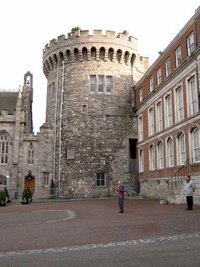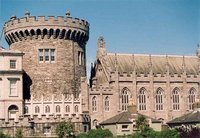Dublin Castle
|
|
Dublin Castle in Dublin, Ireland was the seat of British rule in Ireland until 1922. The building itself mainly dates from eighteenth century, though a castle has stood on the site since the days of King John, the first Lord of Ireland. The Castle served as the seat of British government of Ireland under the Lordship of Ireland (1171-1541), Kingdom of Ireland (1541-1800) and United Kingdom of Great Britain and Ireland (1800-1922).
It fulfilled a number of roles over the centuries. It was first and foremost a royal residence, resided in by the Lord Lieutenant of Ireland or Viceroy of Ireland, the representative of the King or Queen. The Viceregal Apartments (now called the State Apartments) remain one of the most splendid sites in Dublin, and are the location of the inauguration of the President of Ireland. The second in command in the Dublin Castle administration, the Chief Secretary for Ireland, also had his offices there. Over the years, parliament and the law courts met there, before moving to new purpose-built venues. It also served as a military garrison.
Throughout the British occupation of Ireland, "Castle Catholic" was a pejorative term for Catholics who were seen to be overly friendly with or supportive of the British administration.
Famously, the Irish Crown Jewels were stolen from the Castle in 1907.
During the Anglo-Irish War the Castle was the nerve centre of the British effort against Irish separatism. In the course of the conflict, IRA leader Michael Collins gained access with the help of a Dublin Metropolitan Police detective, Ned Broy. This allowed him to read the files of his enemy's best agents, thus eliminating the usefulness of many British agents and spies throughout Ireland.
The Castle ceased to be used for government purposes when the Irish Free State came into being in 1922. It served for some years as temporary Courts of Justice (the Four Courts, the home of the Irish courts system had been destroyed in 1922.) Once the courts moved out, Dublin Castle was used for state ceremonial. Eamon de Valera as President of the Executive Council on behalf of King George V received credentials from ambassadors to Ireland there in the 1930s. In 1938 it was used for the inauguration of Douglas Hyde as President of Ireland. Inaugurations of subsequent presidents took place there in 1945, 1952, 1959, 1966, 1973, 1974, 1976 1983, 1990 and 1997. President Erskine Hamilton Childers' lying-in-state took place there in November 1974, as did that of former President, Eamon de Valera, in September, 1975.

After major refurbishment, the Castle is used as conference centre. It is also a major tourist venue. During Ireland's presidencies of the European Union, including most recently in the first half of 2004, European Council meetings have taken place there.
The crypt of the Chapel Royal is now used as an arts centre, while rock concerts sometimes take place in its grounds. The Castle itself is normally open to the public, except when it is being used for state functions. Among the areas that can be seen are St. Patrick's Hall, a massive ballroom now used for the inauguration of the President of Ireland, the Throne Room, which contains a throne from the reign of King William III at the end of the seventeenth century, and the Viceregal Apartments, including the bedrooms and dining rooms of the Lord Lieutenant and visiting members of the Royal Family. The last person to stay in the royal bedrooms was Margaret Thatcher, who stayed there during the 1979 European Council meeting.
Dublin Castle is currently maintained by the Office of Public Works, its most prominent tenants currently are the Revenue Commissioners.
See also
External link
- Dublin Castle website (http://www.dublincastle.ie/)de:Dublin Castle


